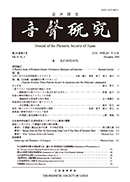Volume 7, Issue 1
Displaying 1-19 of 19 articles from this issue
- |<
- <
- 1
- >
- >|
-
Article type: Cover
2003Volume 7Issue 1 Pages Cover1-
Published: April 30, 2003
Released on J-STAGE: March 31, 2018
Download PDF (1578K)
Feature Articles: Issues in Historical Phonology
-
Article type: Article
2003Volume 7Issue 1 Pages 3-4
Published: April 30, 2003
Released on J-STAGE: August 31, 2017
Download PDF (2890K) -
Article type: Article
2003Volume 7Issue 1 Pages 5-13
Published: April 30, 2003
Released on J-STAGE: August 31, 2017
Download PDF (11819K) -
Article type: Article
2003Volume 7Issue 1 Pages 14-22
Published: April 30, 2003
Released on J-STAGE: August 31, 2017
Download PDF (13230K) -
Article type: Article
2003Volume 7Issue 1 Pages 23-34
Published: April 30, 2003
Released on J-STAGE: August 31, 2017
Download PDF (16098K) -
Article type: Article
2003Volume 7Issue 1 Pages 35-46
Published: April 30, 2003
Released on J-STAGE: August 31, 2017
Download PDF (17051K) -
Article type: Article
2003Volume 7Issue 1 Pages 47-57
Published: April 30, 2003
Released on J-STAGE: August 31, 2017
Download PDF (15532K)
Research Articles
-
Article type: Article
2003Volume 7Issue 1 Pages 58-69
Published: April 30, 2003
Released on J-STAGE: August 31, 2017
Download PDF (16618K)
Research Notes
-
Article type: Article
2003Volume 7Issue 1 Pages 70-76
Published: April 30, 2003
Released on J-STAGE: August 31, 2017
Download PDF (7968K)
Summaries of Talks at the Regular Research Study Meeting No. 306
-
Article type: Article
2003Volume 7Issue 1 Pages 77-
Published: April 30, 2003
Released on J-STAGE: March 31, 2018
Download PDF (1302K) -
Article type: Article
2003Volume 7Issue 1 Pages 77-
Published: April 30, 2003
Released on J-STAGE: March 31, 2018
Download PDF (1302K) -
Article type: Article
2003Volume 7Issue 1 Pages 77-
Published: April 30, 2003
Released on J-STAGE: March 31, 2018
Download PDF (1302K) -
Article type: Article
2003Volume 7Issue 1 Pages 77-
Published: April 30, 2003
Released on J-STAGE: March 31, 2018
Download PDF (1302K) -
Article type: Article
2003Volume 7Issue 1 Pages 77-
Published: April 30, 2003
Released on J-STAGE: March 31, 2018
Download PDF (1302K)
Administrative Reports
-
Article type: Appendix
2003Volume 7Issue 1 Pages 88-89
Published: April 30, 2003
Released on J-STAGE: March 31, 2018
Download PDF (2638K)
-
Article type: Appendix
2003Volume 7Issue 1 Pages 89-
Published: April 30, 2003
Released on J-STAGE: March 31, 2018
Download PDF (895K)
-
Article type: Appendix
2003Volume 7Issue 1 Pages 82-
Published: April 30, 2003
Released on J-STAGE: March 31, 2018
Download PDF (51K) -
Article type: Appendix
2003Volume 7Issue 1 Pages App6-
Published: April 30, 2003
Released on J-STAGE: March 31, 2018
Download PDF (69K) -
Article type: Appendix
2003Volume 7Issue 1 Pages App7-
Published: April 30, 2003
Released on J-STAGE: March 31, 2018
Download PDF (69K)
- |<
- <
- 1
- >
- >|
